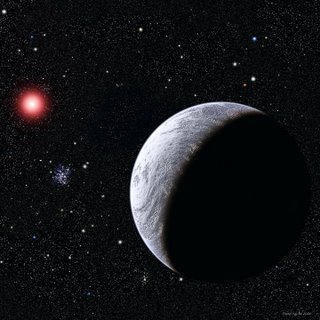It's a breeze

Despite having been a scientist most of my life - one of my earliest memories is of being told not to ask so many questions - I'm still amazed by how much information can be wrung from the natural world.
Astronomers from the University of Washington have just figured out that three planets around distant stars have winds blowing on them up to 9000 miles an hour. Now that's big winds. My garden fence blew down last night in a January storm that reached 70 miles an hour. They must build their fences strong on 51 Pegasi's planet.
Of course there are no people there, or on the planets orbiting HD179949b or HD209458b, the other two star systems studied. These are gas giants like Jupiter, only much closer to their parent suns. So they’re hot – about 925 degrees Celsius at their surfaces – and their atmospheres are pretty poisonous.
Anyway the point is that just discovering these planets is a major achievement. No telescope on Earth can see them. The closest is 50 light years away – that’s 294 million million miles. Even the Hubble Space Telescope can’t see them.
So how do they know they’re there? The most common technique uses the fact that the gravity of the planet pulls its sun slightly out of position. Planet and sun waltz around each in a gravitational dance. But because the sun is so much more massive than the planet, it moves much less.
All the same, this movement can be detected because it affects the colour of the light that reaches us from that sun. From the regular cycles in this light you can work out the mass of the planet, its distance from its sun, and how long it takes to complete one orbit (the length of its year).
That’s a lot of information from a pinpoint of light. But there’s more. The gravity of an object causes tidal forces on a nearby object, just like the tides we have on Earth. These tidal forces slow down a planet’s rotation, and over a long time stop it completely. The closer the two bodies the sooner this happens.
The sums show that all these planets have stopped spinning, so their days last forever and so do their nights. The day side facing the sun should be as hot as Hell, while the night side should be colder than an Aberdeen winter.
But they don’t seem to be. How do we know? Well all that information about the planet’s orbit around its sun tells us when the day side is facing Earth across the depths of interstellar space, and when the night side is facing Earth.
Now hot objects emit copious quantities of infrared radiation, cold objects much less. So if you study these systems with infrared telescopes – these scientists used the Spitzer Space Telescope – you can work out the temperature. That’s where the 925 degrees Celsius for the surface temperature of the planets comes from.
But the really surprising part is that the astronomers could detect no difference in temperatures between the night and day sides of these planets – despite the fact that one has no source of direct heat while the other’s sky is filled by a blazing sun.
So the heat must be getting from the day side to the night side – carried by winds so strong that my garden fence would be knocked down, blown away and blasted into its constituent molecules.
As I said, what science can do with a sprinkling of data and a dash of knowledge constantly amazes me.
BACK to the story at realscience.org.uk (Scroll down to: It's a breeze)

0 Comments:
Post a Comment
<$I18N$LinksToThisPost>:
Create a Link
<< Home